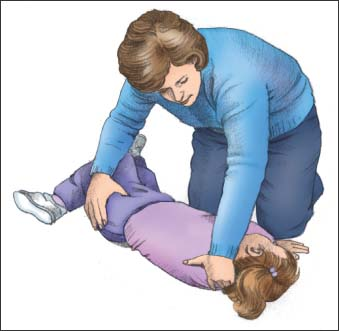Cardiopulmonary Resuscitation, Child
An adult who needs cardiopulmonary resuscitation (CPR) typically suffers from a primary cardiac disorder or an arrhythmia that has stopped the heart. A child who needs CPR typically suffers from hypoxia caused by respiratory difficulty or respiratory arrest.
Most pediatric crises requiring CPR are preventable. They include motor vehicle accidents, drowning, burns, smoke inhalation, falls, poisoning, suffocation, and choking (typically from inhaling a balloon, small object, or food, such as a hot dog, rounded candy, nut, or grape).1 Other causes of cardiopulmonary arrest in children include laryngospasm and edema from upper respiratory infections.
The goal of CPR is the return of spontaneous circulation. However, CPR techniques differ depending on whether the patient is an adult, a child, or an infant.1
For CPR purposes, the American Heart Association defines a patient by age. An infant is younger than age 1; a child is age 1 to puberty.1 Survival chances improve the sooner CPR begins and the faster advanced life-support systems are implemented. However speedily you undertake CPR for a child, though, first determine whether the child’s respiratory distress results from a mechanical obstruction or an infection, such as epiglottiditis or croup. These infections require immediate medical attention, not CPR. CPR is appropriate only when the child isn’t breathing or is only gasping.1
This procedure is specific to CPR performed by health care providers.
Equipment
Backboard or other hard surface ▪ automated external defibrillator (AED) ▪ gloves ▪ Optional: disposable child-size airway equipment.
Implementation
Gently tap the child and ask loudly, “Are you okay?” Call the child’s name if you know it to elicit a response.1 If the child is conscious but has difficulty breathing, help her into a position that best eases her breathing—if she hasn’t naturally assumed this position.1
Call for help to alert others and to enlist emergency assistance. If you’re alone and the child isn’t breathing or is only gasping, perform CPR for 5 cycles (2 minutes) before calling for help. A single cycle for a lone rescuer is 30 chest compressions and 2 breaths.1
Put on gloves, if available, to prevent exposure to potentially infectious blood and body fluids.
Position the child in the supine position on a firm, flat surface (usually the ground).1 The surface should provide the resistance needed for adequate chest compressions. If you must turn the child from a prone position, support her head and neck and turn her as a unit to avoid injuring her spine (as shown below).
 |
Restoring Heartbeat and Circulation
Assess circulation by palpating the carotid artery for a pulse.1
Locate the carotid artery with two or three fingers of one hand. Place your fingers in the center of the child’s neck on the side closest to you, and slide your fingers into the groove formed by the trachea and the sternocleidomastoid muscles (as shown below). Palpate the artery for no more than 10 seconds to confirm the child’s pulse status.1
Stay updated, free articles. Join our Telegram channel

Full access? Get Clinical Tree


Get Clinical Tree app for offline access
